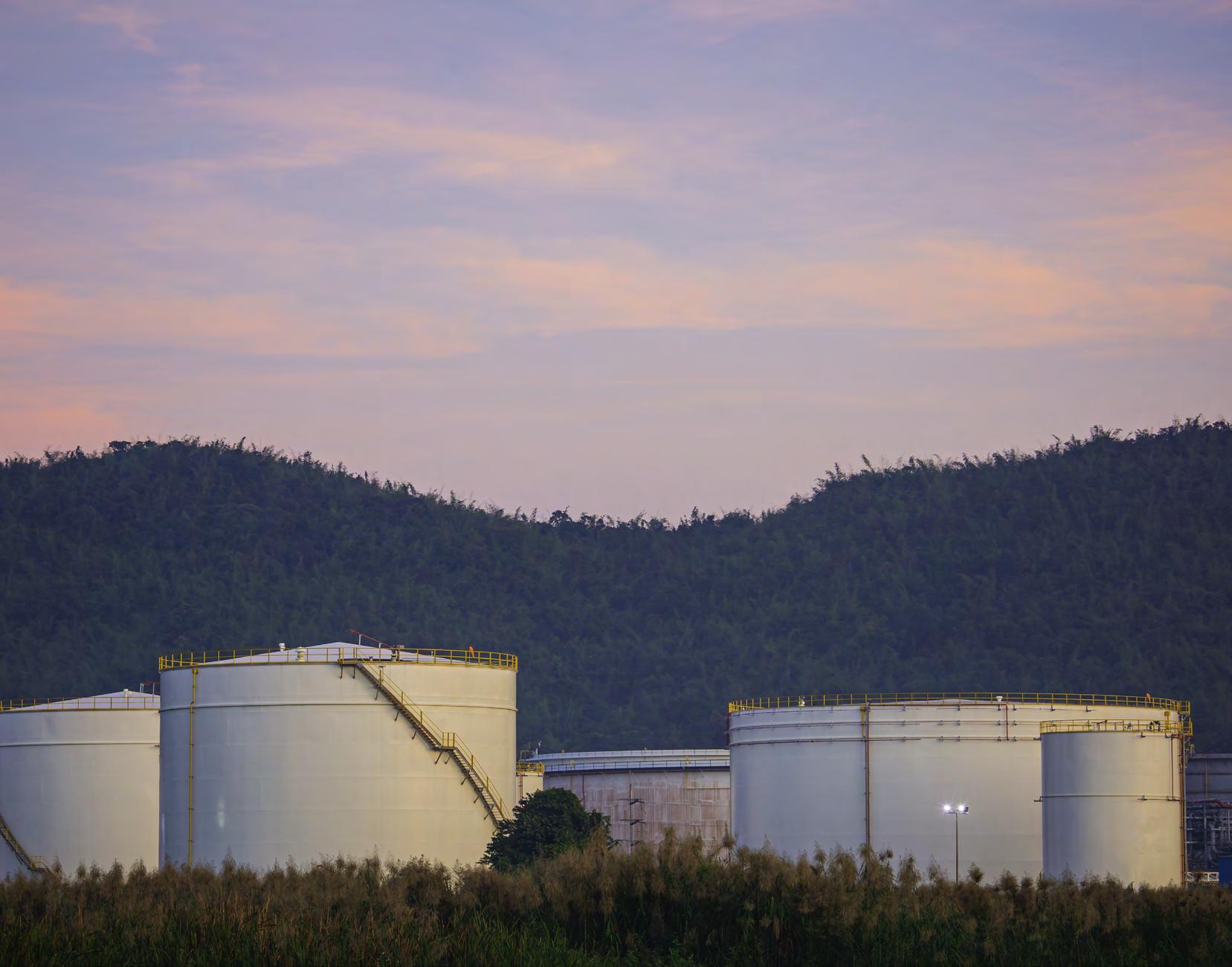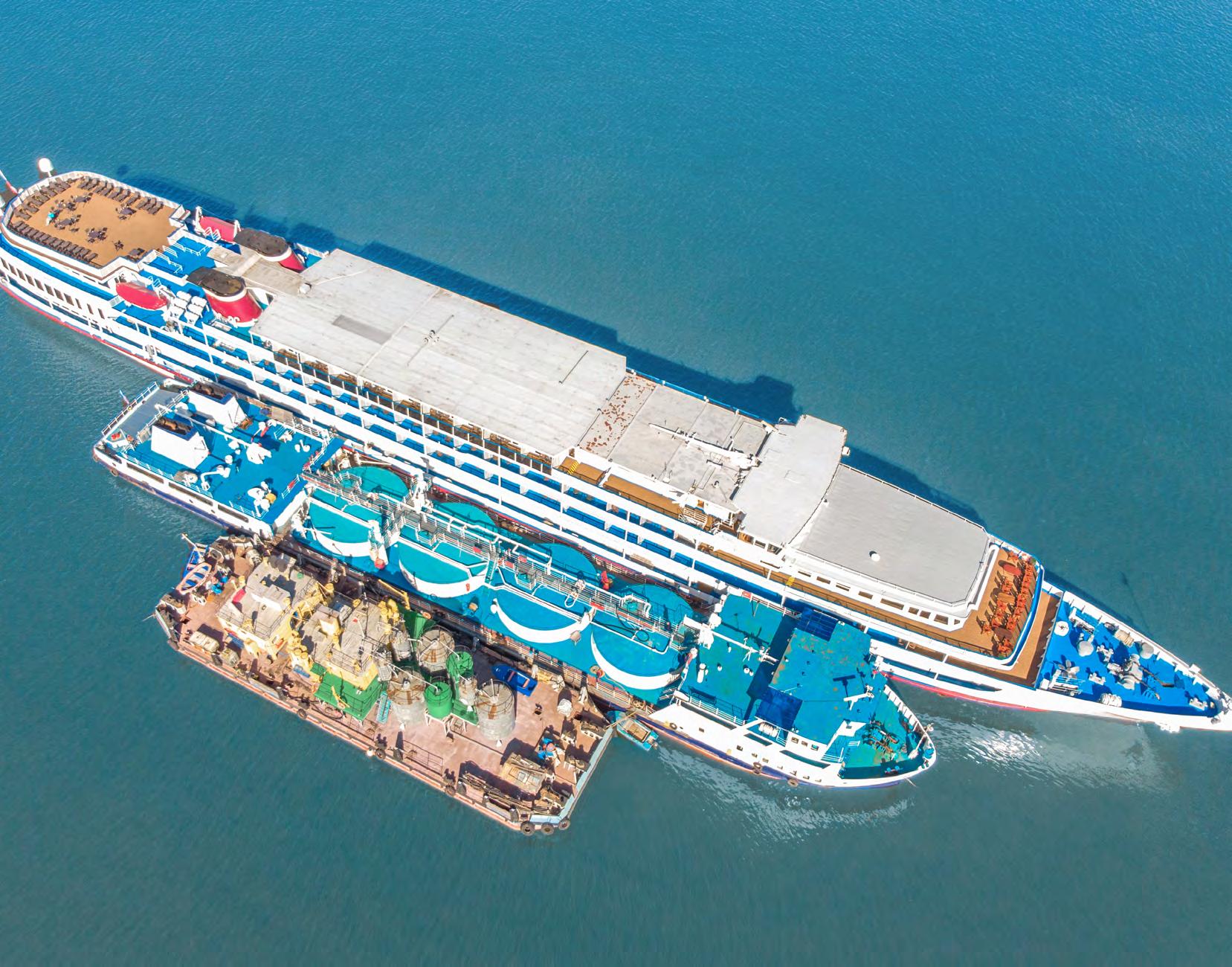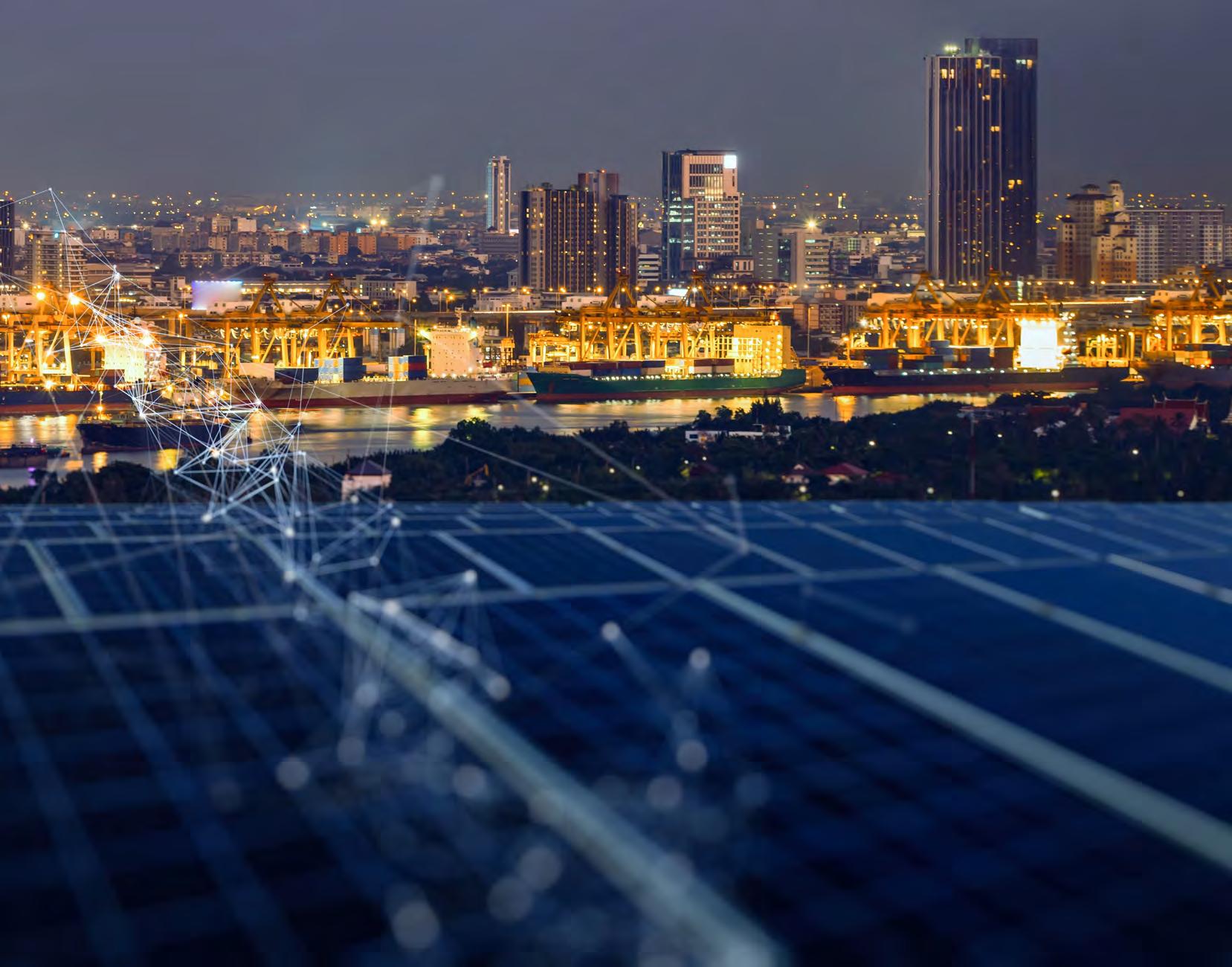
14 minute read
BALLAST WATER
from CSI Summer 2022
by Maritime-AMC
FIRST, outlines the company’s approach to the aftpeak ballast water tank problem

SOLVING THE
AFTPEAK PROBLEM
Aftpeak ballast water tanks typically hold around 5% of the total volume of ballast water onboard a tanker, and play a very different function to a ship’s primary tanks. Yet their crucial role in cooling tube bearings in the vessel’s stern and dampening propeller vibrations means that these tanks are relatively rarely ballasted and deballasted – while the risk of oil contamination from adjacent cargo tanks means they are completely separated from primary tanks.
As aftpeak tanks are covered by ballast water rules, and therefore must have a ballast water treatment system (BWTS) that meets required treatment standards installed, they represent a unique challenge not met by most conventional BWTS. Tanker owners must either find a practical solution, in terms of scale, complexity, and cost, or decommission these aftpeak tanks – and lose their functionality.
Most BWTS use a two-step process to treat water, with water first filtered through a specially-designed system before going through either UV treatment or electrochlorination. This delivers reliable and cost-effective treatment at the scale required for a large ship’s primary ballast water tanks.
However, these systems pose real problems when treating tanks only a fraction of the size of those primary tanks – even when the systems are miniaturised.
Two-stage ballast water treatment creates efficiencies when dealing with large amounts of water. However, these efficiencies do not work on a smaller scale; filters take up precious space, while the UV or electrochlorination systems have minimum footprints in terms of both space and energy use.
As aftpeak ballast water systems must be installed in a busy and crowded lower aft engine room, space is at a premium. The logistics of re-arranging or amending existing systems to meet a BWTS’ requirements is inherently expensive, and in extreme cases could easily double a shipowner’s installation costs.
At the same time, a two-stage BWTS can be difficult to operate and maintain. Complex processes can be difficult for crews to remember, especially for a system which is infrequently used. Installing a complex two-stage system creates a high risk of mistake or undetected damage.
Solutions that work well for primary tanks do not deliver value for aftpeak tanks. This means that meeting tanker owners’ technical and logistical aftpeak ballast water challenges requires a new approach to BWTS.
This new approach necessitates aftpeak ballast water systems specifically designed for operation in aftpeak areas – that are easy to operate, small, and effortlessly reliable.
At ERMA FIRST, our oneTANK system was developed specifically to meet these requirements.
By utilising filterless technology and using chemical based treatment that removes the need for UV lamps or electrolytic chlorine generators, oneTANK has delivered an incredibly small footprint of less than 60cm squared. Treatment is delivered by a simple circulation loop and mixing nozzles injecting liquid bleach into the tanks, which can often be delivered by using an existing general service or fire pump.
Together, this cuts out the issues other systems pose in integration and installation. By having such a small footprint, and by using only existing infrastructure, oneTANK provides a seamless solution to an owner’s lower aft engine room crowding issue.
By removing the complicated to operate filters, UV, and electrochlorination equipment associated with most other BWTS, oneTANK is easy for crews to use. This also means that the system only requires readily available and commonly used chemicals.
Together, these innovations mean that oneTANK’s power consumption is similar to that of a household washing machine.
As we near final D-2 compliance deadlines, aftpeak ballast tanks are continuing to pose a challenge for tanker owners. To lose their use, and the operational benefits they represent, would create commercial challenges for shipowners in an incredibly competitive segment – while conventional systems could easily damage profitability.
Owners need to consider their needs, under the regulations and operationally, and evaluate all the options. A small, filterless, and easy-to-use BWTS may be the perfect solution.
OTHER NEWS
BIO-SEA AGREEMENT
Germany’s Hagedorn Products has added the commissioning, maintenance and servicing of BIOSEA ballast water treatment systems to its existing sales agreement with France’s BIO-UV Group.
Close to the major shipping hubs of Hamburg and Bremerhaven, Hemmoor-based Hagedorn will now provide BIO-SEA service support to new and existing customers throughout Germany, its border countries, and Finland.
Commenting on the partnership, Maxime Dedeurwaerder, business director, BIO-SEA, says: “Hagedorn has a successful track record promoting the full range of BIO-SEA UV-based ballast water treatment systems to shipowners, ship managers and shipyards across the region, so we are delighted to extend the company’s remit to include maintenance services.”
The renewed and expanded agreement is part of BIO-SEA’s wider expansion strategy to meet growing market demand for in-service ballast water treatment system services.
“We are delighted to extend our collaboration with Olaf Hagedorn and his team to strengthen BIO-SEA’s position in this booming market,” says Dedeurwaerder. “The majority of shipowners have of course installed a BWTS but operators will now need global support to troubleshoot, maintain, and service their systems on a regular basis.”
Dedeurwaerder anticipates that more and more vessels will also need specialist support with annual compliance checks.
“It is anticipated that port state control BWTS compliance inspections will increase at ports around the world in coming years,” he says. “Therefore, we do advise the regular testing and maintenance of installed systems as a matter of course.”
While annual system performance tests are currently mandatory under USCG regulations they are recommended by the International Maritime Organization.
Hagedorn Products managing director Olaf Hagedorn says: “We are pleased to expand the relationship with BIO-UV Group and look forward to assisting new and existing BIOSEA customers with their BWTS installation requirements and ongoing maintenance needs.
“Our engineering teams and service personnel have completed BIO-UV Group’s technical training course and are now approved to provide a complete one-stop-shop BIO-SEA solution.”
Hagedorn adds: “For ballast water treatment system manufacturers it is necessary to establish a network of service centres at key maritime locations around the world to support vessel operations. With a service partner like Hagedorn – close to the major ports of Hamburg, Bremerhaven, Cuxhaven – BIO-SEA can support shipowners in the region at short notice.”

Mark Riggio, head of
marine at Filtersafe, outlines the current rules regarding challenging water conditions, explains why blanket exemptions are unlikely, and provides advice for shipowners and operators concerned about these issues

Mark Riggio Head of Marine, Filtersafe
BRIDGE OVER
TROUBLED WATERS
Ballast water management in ports with troubling water conditions has recently gained widespread attention. Groups representing shipowners and operators have submitted letters to the International Maritime Organization (IMO) reporting incidents in which ballast water management systems (BWMS) have been rendered inoperable by poor water quality. While these water conditions do pose significant operational challenges, there is sufficient technology and equipment available on the market today to overcome them.
One of the most common features of a port with “challenging water conditions” is a high level of total suspended solids (TSS). These waters can be found all over the world, from Shanghai to Mississippi and Hamburg to Rotterdam. But, as the band Beautiful South once sang, “this could be Rotterdam or anywhere”, as conditions and TSS levels regularly fluctuate based on weather, seasons, tide, traffic and so on.
MEPC 77 merely reinforced the status quo when it comes to ballast water management in ports with challenging water conditions and there are currently no blanket exemptions or bypassing of systems for ships operating in these conditions. There is no real basis for blanket exemptions. They would be contrary to the environmental aims of the Ballast Water Management Convention (BWMC) and against the UN Sustainable Development Goal 14 Life Below Water. Exceptions would allow cheap, lowquality systems to be by-passed in less-thanideal ballasting conditions.
The desire for blanket exemptions highlights the challenges that shipowners and operators face if they purchase a poorly performing BWMS or filter. Filtersafe has seen cases where filters have been retrospectively added to filterless systems ahead of operations in sediment-rich waters. The team was also asked to retrofit one of its high-quality filters as a “pre-filter” to a shipowner’s existing system and low-quality filter from another supplier.
While these workarounds are effective,
they are a needlessly expensive and complex route to compliance when compared with simply fitting an appropriate BWMS with a highperforming filter from the outset.
Without blanket exceptions, there are essentially two options. The first is to seek concessions for a low-quality system. This involves operators taking the risk that they can succeed with running a low-quality filter and ineffective system, asking to use contingency measures on a case-bycase basis. This is not a long-term solution and has high opportunity costs. Crew will waste time, and therefore operators’ money, negotiating with the port on current water quality and whether they are compliant or not.
There also remains a high risk that the vessel will not comply with regulations; resulting in fines, damage to reputations and the eventual need to install an effective system at extra cost. Additionally, using contingency measures may result in contamination of ballast tanks and piping, increasing the risk of downstream compliance testing failures long after leaving challenging waters.
The second option, which is much simpler, is to ensure that purchasers are buying a BWMS and filter designed for the vessel’s route and operating profile. Initial CAPEX costs may be marginally higher, but OPEX costs are much lower. Operational delays and disruption and loss of hire are minimised, maximising trading time and profit. When properly evaluated, it’s an obvious choice. So, how do you spot an appropriate high-quality system?
While current IMO testing standards require a BWMS and filter to function at 50mg/L TSS, ports such as Shanghai have TSS levels of up to 1,000mg/L. To simulate these conditions and to highlight how a BWMS and filter performs in real waters, the Shanghai Test was developed. This test is the gold standard for filters – which remain at the very heart of a BWMS – especially a system that is effective in sediment-rich waters.
The first piece of advice for owners and operators is to check the Shanghai Test score of the filter used in your prospective BWMS. Control Union, which independently verifies the tests, considers filtering to 1,000mg/L without clogging a pass. However, some filters, such as Filtersafe’s BS 101E filter with a 40µm and standard scanner, have filtered water as high as 2,450mg/L.
A scalable cleaning mechanism is key to success in the Shanghai Test and therefore to success in sediment-rich waters. Cleaning can then be increased when ballasting in challenging water conditions to ensure a consistent flow rate and avoid clogging. Choosing a filter with an automatic self-cleaning capability will also save crew time and effort, allowing them to focus on other ballasting priorities.
Another key question to ask when choosing a system is, does this system keep my ballast tanks clean? A good BWMS filter doesn’t just remove harmful organisms, it also filters sediment and other debris that can accumulate in ballast water tanks. You need to clean these out for safety, regulatory and vessel efficiency reasons. Not to mention the extra carrying capacity you have without heavy sediment on board.
Ballast water management is one of the toughest water treatment challenges in the world – therefore it demands the best technical solutions. Ship owners and operators who don’t put time and effort into choosing an appropriate BWMS and filter will be caught out and will ultimately end up paying more or paying twice for a BWMS.
It is also important to choose a supplier who provides after-sales support and has in-depth knowledge. Manufacturers should work in partnership with crew when they need assistance in managing challenging water conditions. This approach is essential, not least because ships’ crew have many, higher-priority tasks to complete during ballasting operations.
The bottom line is, operators should ask their vessel owners to purchase a high-quality system and shouldn’t charter a vessel with a poor one, especially if they’ll be charting potentially troubling, sediment-rich waters. Owners should ask shipyards to fit a BWMS with a high-quality filter when purchasing a new vessel or retrofitting a system. Otherwise, in the words of Abba, you’ll likely to be losing “money, money, money”.

ECOCHLOR: A FLEXIBLE APPROACH TO BWMS
Ecochlor was founded in 2001 to provide simple, reliable, cost-effective and easy-to-use ballast water management systems (BWMSs) that can stand up to the most stringent regulations in the world.
Our BWMSs are “engineered for reliability” all the way down to the component level and are simple to operate with very few major components to maintain. This ensures maximum uptime, minimising equipment failure and extending the life of the BWMS. Therefore, OPEX costs are reduced, giving peace of mind to ships’ crew when entering any port worldwide.
Ecochlor systems use a chlorine dioxide (ClO2) treatment technology, which is highly effective in ALL water conditions – its efficacy is not affected by salinity, temperature or turbidity, allowing for more flexibility with a ship’s trade routes.
Filtration is not necessary prior to treatment because ClO2 is not affected by suspended sediments or turbidity and primarily only reacts with living organisms.
Our range of BWMS put shipowners back in control of the ballast water management process by allowing them to choose which mode of operation is best for their vessels.
Our BWMS line of products includes:
ECOCHLOR® BWMS (FILTRATION & ClO2)
Vessels operating this system can operate anywhere in the world with no restrictions when it comes to temperature, salinity, or turbidity. FILTERLESS EcoOne® BWMS (ClO2 ALONE)
Vessels operating this system can operate anywhere in marine and brackish waters (≥ 1 PSU), with no restrictions on temperature or turbidity.
HYBRID EcoOne® BWMS (FILTRATION & ClO2 OR ClO2 ALONE)
This system allows shipowners to operate their BWMS either with or without a filter. This option is suited to shipowners who wish to have the flexibility of unrestricted operation globally, with the convenience of a no-filter system. Vessels that already have an Ecochlor BWMS with filters installed can easily upgrade to the hybrid option.


EcoOne® filterless ballast water management system generator
Did you know? Ecochlor technicians analyse data from every ballast operation to ensure system operability. Currently, 98% of Ecochlor’s installed systems are operational. All Ecochlor® BWMSs are International Maritime Organization and United States Coast Guard Type Approved. This stringent testing demonstrates that our technology can meet and exceed demanding regulations for compliance.
ECOCHLOR BWMS BENEFITS
Ecochlor’s BWMSs offer numerous advantages: » Filterless operation available with
EcoOne® and Hybrid variants » No problematic Total Residual
Oxidants (TRO) sensors that can interrupt ballasting or deballasting operation » No electrodes » No complex power supplies » Very low energy requirements, possibly the lowest in the industry » No secondary treatment or neutralisation allows for overboard de-ballasting from topside tanks » Only minor piping modifications for installation » Treatment for flow rates up to 16,200 m3/hour » Low power costs when cold ironing » Very low CO2 footprint Did you know. We now offer turnkey installation options?. Through a network of partners, Ecochlor offers a full range of options to provide shipowners additional support for system installations. These services include: » Integration engineering » Door-to-door shipping, including assistance with ocean or air shipping, customs clearance and storage » Installation supervision and commissioning testing attendance (with Class approval) » Purchase and shipment of highgrade steel and plastic pipe » Materials to support the installation » Spare parts for redundancy on board the vessel
The installation of an Ecochlor system initiates a relationship with the shipowner and operator that will last for the life of the vessel. Ecochlor has service engineers located throughout the US, Europe and Asia. We supply both local assistance and support, as well as having regional service managers in the US, China, Singapore and Europe.
We continue to strengthen our in-house team supported by carefully selected authorised installation and service partners strategically located worldwide.
Our spare parts and service network is located in multiple areas throughout the three major time zones to offer real-time response to our clients.
Everyone knows that Ecochlor’s BWMSs are very simple to operate, but we still offer multiple training alternatives for the crew postcommissioning. While on board for our chemical resupply approximately twice a year, we can provide shipboard training to any new crew members, as well as a simple maintenance check on the system if time allows. We also offer computer-based training, training at the shipowner’s facility and virtual training for the crew or land-based offices.
CHEMICAL RESUPPLY
We manage the logistics for: » Tracking chemical use with information supplied by the crew after every ballast operation » Ordering and delivering chemicals to the nearest port or vessel » Filling the chemical storage tanks and clean up
Ecochlor is here for the long-term to provide reliable BWMS and as an Innovative “Green Marine” Technology Company. This year marks Ecochlor’s 21st year in the BWMS marketplace. We aren’t in this business for the shortterm: our focus is to continue to offer shipowners systems that keep their vessels compliant both now and well into the future.
Additionally, our collaborations with other innovative maritime environmental technology providers have made Ecochlor a Green Marine technology and service solutions company, providing more than just BWMSs for our clients.

For more information, visit: ecochlor.com










